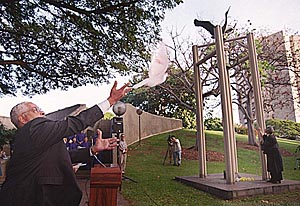Posted on: Sunday, March 11, 2001
Japanese have apologized adequately for bombing
 |
| Kenneth Joyner of Hawaii Kai, releasing a pigeon in the name of one of the victims of the Ehime Maru tragedy, was among more than 50 people gathered earlier this month at the Nagasaki Peace Bell on the Honolulu Hale civic grounds to remember the students, instructors and crew members missing and presumed dead since the USS Greeneville collided with the Japanese fishing boat. The bell was rung for every victim.
Advertiser library photo • Feb. 23, 2001 |
 Japan failed to express regret for war horrors Japan failed to express regret for war horrors
By Marsha Joyner
Apology is in the air. In the aftermath of the sinking of the Ehime Maru, many complain that while the United States is expected to apologize to Japan for this tragic accident, the Japanese have failed to adequately apologize to the United States and the people of Hawai‘i for World War II and the bombing of Pearl Harbor.
I think they have, in many ways.
Each day, hundreds of people from Japan — some not even born at the time of World War II — come to the Arizona Memorial, each in his own way, to pay respects and cast lei upon the waters.
There are people within the peace movement in Japan moving to ensure that the government and the textbooks accurately reflect, and take responsibility for, the horror of war.
More important for the people of Honolulu, the Nagasaki Peace Bell, on the grounds of Honolulu Hale, is a gift of peace and reconciliation to the people of the city of Honolulu from the survivors of the atomic bombing of Nagasaki and their supporters.
Recognizing that true steps to peace must begin with acknowledgment of harmful actions in the past, the survivors in Nagasaki wished to make a gesture of reconciliation to the people of Ho-nolulu, which sustained a military attack by Japan on Dec. 7, 1941.
Working through the organizing efforts of the Congress Against Atomic- and Hydrogen-Bomb Committee of Nagasaki and the Nagasaki Prefecture Hibakusha Membership Association, these victims began a lengthy process of raising money and negotiating with the mayor and the City Council of Honolulu for acceptance and placement of the peace bell monument at a location acceptable and appropriate for the general public.
Through mutual efforts the groups in both cities saw the success of the project in the dedication ceremony on Dec. 7, 1990, on the grounds near Honolulu Hale, when the peace bell was rung for the first time to the great satisfaction of the delegation of 60 or more of the Nagasaki Hibakusha in attendance.
Since that date the bell has been sounded on Aug. 9 to mark the bombing of Nagasaki and on the day observing the birthday of the American peacemaker and promoter of nonviolence, Martin Luther King Jr. Additionally, it has become the site of observances of important occasions in the continuing struggle to end the production and use of nuclear weapons.
Since the Ehime Maru tragedy on Feb. 9, the bell has been the site of one of the many memorial ceremonies for those recent victims.
There are two other peace bell monuments of the same design given to the city of Leningrad (now once more St. Petersburg), Russia, and to a city in Manchuria that felt the brunt of the Japanese military action.
In 1996, the Nagasaki Hibakusha reaffirmed its commitment to the spirit of the bells by sending each of the three cities a gift of $10,000 for maintenance of the monuments.
At the base of the monument a plaque is inscribed with the following message: Nagasaki, the city devastated by the bitter tragedy of a nuclear bomb, dedicates this Nagasaki bell as a symbol of the rebirth of Nagasaki and the desire of its citizens for peace in the future through sincere reconciliation and reflection on the folly of war.
Marsha Joyner is president of the Dr. Martin Luther King Jr. Coalition in Hawai‘i.
[back to top] |

